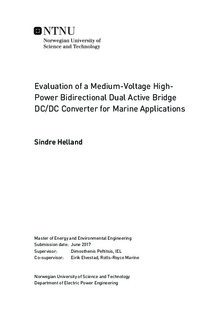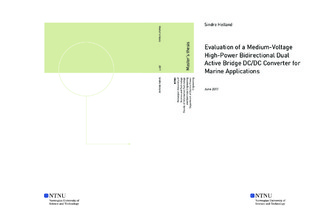| dc.description.abstract | Due to an increased focus on the development of high-power marine microgrids, new vessels are being installed with large power systems including highly fluctuating loads operating at high efficiency and low emissions. The introduction of a battery energy storage system in a shipboard DC grid allows for operating the diesel gensets at variable speeds, not being locked to a fixed frequency or speed. The transient performance of the system can also be improved and an optimal load leveling of the different prime movers can be achieved by the proper implementation of a battery. Thus, the system can operate efficiently with highly fluctuating loads while keeping the fuel consumption low.
In order to integrate the batteries into the shipboard DC grid, high-power bidirectional DC/DC converters are needed. Many converter configurations are available, yielding different advantages and disadvantages. Thus, each different system should be evaluated in order to see which converter topology is best suited for that specific system. The stress levels on the switching devices are also higher than before, which can be seen as a result of the utilization of higher voltages and currents in the shipboard grids. Isolated bidirectional DC/DC converters for high power applications can provide the proper connection, but along with the increased loads comes higher requirements to component ratings as well as a more complex control system.
A high-power medium-voltage DC/DC converter suitable for implementing such a battery is analyzed in this thesis after explaining the shipboard electrical system. The converter has a rated power of 4MW with an equal input and output voltage of 1100V and with a high-frequency transformer providing galvanic isolation between the shipboard power grid and the battery. Its performance is evaluated by means of modeling it in Matlab/Simulink where the focus has been on the switch resonance components in order to achieve a high-performance, soft-switched converter.
A PI controller is also implemented in order regulate the output voltage of the converter for different load levels. As some of the converter requirements are a robust design, high operating efficiency and a fast response, the PI controller is tuned in order achieve this and it is seen that the converter responds fast with small deviations in parameter values for load variations of several megawatts. A gate signal generator is also made, where the output of the PI controller is used as input, delaying the gate signals to switches in either the primary or secondary side, depending on the power flow direction.
The model is used to analyze the current waveforms through the switches and the transformer, and by doing measurements and calculations based on the simulation results, the efficiency of the converter is calculated at different load steps ranging from 0 to 4MW. It is seen that the converter operates at an efficiency of 97.2% at an output power of 4MW with increasing efficiency for lower load levels due to the lower conduction losses. However, the high-frequency transformer is assumed ideal in this thesis and thus the efficiency will be somewhat lower with this included. | |

